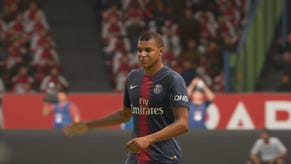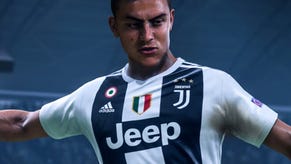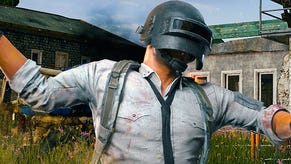FIFA 19 Developers Hint at What to Expect From Career Mode While Going Deep on Gameplay Improvements
INTERVIEW | We talk to creative director Matthew Prior and gameplay producer Kantcho Doskov about what to expect from this year's version.
This article first appeared on USgamer, a partner publication of VG247. Some content, such as this article, has been migrated to VG247 for posterity after USgamer's closure - but it has not been edited or further vetted by the VG247 team.
In some ways, you could say FIFA has nothing to prove. EA's juggernaut soccer franchise is worth near a billion dollars a year through Ultimate Team alone. But there's been an undercurrent of unrest among hardcore fans over the past year, with the transition to Frostbite being squarely in the crosshairs.
To address some of these concerns, FIFA 19 will be introducing a new animation system called "Real Player Motion" this year, which comes on top of full integration of the Champion's League licensing. With luck, this will quiet some naysayers while giving FIFA a solid sense of momentum heading into the last few years of the current generation.
Last week I sat down to talk to FIFA 19 creative director Matthew Prior and gameplay producer Kantcho Doskov. We went in-depth on the balance changes, the impact of RPM, what fans can expect from career mode, and more.
So how surprised were you when Ronaldo went to Juventus?
Matthew Prior: I mean, we're not that surprised in the sense that it's just the world of football. These things can happen. We had it happen before when Gareth Bale went from Tottenham to Real Madrid. And that was much later in the day, so it's happened. It comes with the territory. We always have contingency plans because, particularly with pack talent, no one's bulletproof. So we always have to have a plan, particularly I would say for pack talent.
So, I personally wasn't massively surprised, because there were rumors last year. We just have to kind of, you know, make contingencies. But I like to said, it's part of the territory. It's why we love football. And it happened reasonably early enough that it's not all hands to the pump kind of thing.
So this version feels a lot more refined than the E3 build. What in particular have you polished up?
Kantcho Doskov: In gameplay we've continuously made changes, fixed bugs, and it's not even finished yet. There's another month of just fixing as many bugs as we can: improving the goalkeeper, improving the passing, the shooting. All aspects of it. All of the big features are implemented, especially with the timed finishing, which adds a level of user skill more competitive players. All the tactics are in.
For new users, for more casual players, we've implemented things like a one-button control scheme. So if you're a young user of the game and you just want to press one button to play it, you can do that. There's a ton of things we've added, but I would say the tactics and the Active Touch system are the big ones in gameplay.
I'm glad that you brought up timed shooting, because keepers and shooting were big issues last year, and keepers were either too good or not good enough, and shooting felt kind of gamey in the sense that there were a couple tricks that always seemed to work. Was that something you perceived as well?
Kantcho Doskov: We definitely had feedback that some types of shots, like the low-driven shot, where you double tap the button and it goes to the far post, that was something that the professional players seemed to use all the time. We did see it. By introducing the timed finishing feature, we wanted to add more skill to that mechanic, because just tapping the button mindlessly doesn't take much skill.
Now you have to be precise with that second button press, and depending on the situation it may be tap-tap, or it may be tap, and then tap. So it takes a lot more precision on that second button press, and you have to watch as that ball flies to your player and press it just at the right moment. Otherwise, if you make a mistake, you might miss the target completely. And again, it's a feature that you don't have to use if you don't want to, because it is a risk. The probabilities will be higher to score if you actually time it right, but if you don't, you may miss the target. So it's up to you.
Yeah. I was a little hazy on timed finishing, because when I was shooting, I always did tap-tap anyway. So I was trying to gather what exactly about this was different. It's just the timing is more precise?
Kantcho Doskov: Yeah, it's the timing. So it's just as you're about to contact that ball. If I'm going to head the ball, for example, I power up as I normally would, you know, point to where I want the ball to go. Then just as the ball comes and about to contact it with my head, that's when I need to press shoot for the second time. If I do it too early, like before the animation even starts, that's too early, so I'm going to get more error, more inaccuracy on the shot. We're trying to simulate this thing where perfect contact means better accuracy, more power. So that's where the precision and timing comes into play.
So one thing I noticed as I was playing some games today: RPM seems to widen the gap even further when it comes to the quality of individual teams. For example, I was playing as Juventus against Real Madrid, and it felt like, especially in the midfield, I was having a fair amount of trouble. Real Madrid just seemed better, like they were able to press a lot harder. They were having some advantage with the Active Touch system. The animation seemed to favor them even more than usual. What are your thoughts on that?
Kantcho Doskov: Yeah. So we have expanded the Real Player Motion Technology this year into other actions that you can do. For example, if you slide tackle and you're getting up, now you can decide where you want to go. In previous years, you would just be locked into a get-up animation that would go in this direction. But then, if the ball during the middle of that animation went somewhere else and you tried to go in that direction, you would be stuck through the animation.
But with the RPM technology, it allows us to transition at any time. It's so much more responsive and fluid. You can break out of animations in a natural way at any time. Whether you're getting up, whether you're running, whether you're even stumbling. Somebody could shoulder barge you, and you could be stumbling this way, but because your left stick is pointing that way, you have some freedom. You could actually steer your player in a different direction, which is something we never had in FIFA before. It was very static. It was like, player stumble animation this way. Wait for it to finish. Okay, now you can go that way. So it's a lot more responsive.
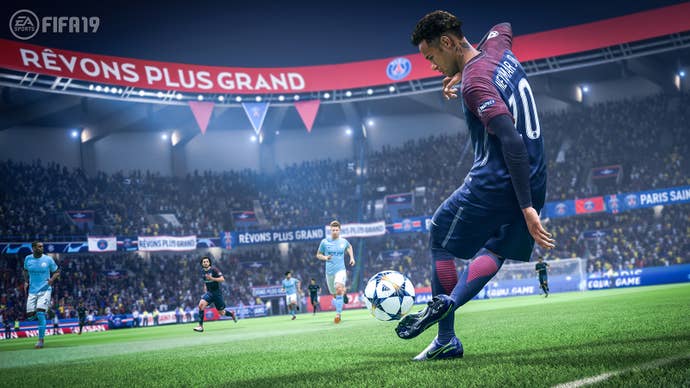
Over the last few years you've been releasing regular gameplay updates and patches. I feel like last year's balance changes brought some really mixed reactions within the community. How did you feel about that, and did last year's run teach you anything about updating for this year?
Kantcho Doskov: Yeah, we definitely had a lot of feedback on the patches. Some players were getting used to the gameplay when it came out, and then the patch came. We've had to reconsider when we release patches. In each of those patches, we were fixing bugs that people told us about, like the goalkeeper wasn't saving certain shots, or passing was too accurate.
But in terms of sort of the timing and the communication that we had with the community, I think that's something we're going to do a better job of this year. We're going to be much more transparent about what changes are coming up, and why we did them, and what was the feedback that led to those changes. But all of the patches that we made in gameplay for FIFA 18 were based on feedback from the game coming out and people saying, "This is too OP," or, "This is not effective enough." And we tried to rebalance once we confirmed that they were issues.
Getting back to the keepers really quickly, that was a big focus of the discussion aside from the pacing of the gameplay. A lot of people were just like either the keeper saved everything, or they saved nothing. It's so hot and cold and it doesn't feel realistic. What are your thoughts on that?
Kantcho Doskov: Yeah. The goalkeeper is one of those positions where, if he makes a mistake, it could very easily lead to a goal. So, it's a very tricky one to get right. Obviously, in real life we've seen that even in the Champions Final there was a mistake by Loris Karius-just a simple catch and he missed it. There was one in the World Cup Final, Hugo Lloris, where he tried to like ... I don't know what he was trying. So these things do happen in real world, and in FIFA as well, but we try to make the goalkeepers feel reliable, so they are able to save the ball when you would expect them to. But there's always a chance that they won't. It's trying to find that balance, right? Especially with the timed finishing. There is still balancing that we need to do until the game is finished, to make sure the shooting's not overpowered.
"We're going to be much more transparent about what changes are coming up, and why we did them, and what was the feedback that led to those changes."
Are there any specific improvements that you've made to the keeper in this year?
Kantcho Doskov: Yeah. Definitely. He has the transition from a save to save. So similar to the RPM technology, if he's diving in one direction, and a shot comes in and it gets deflected from a defender. If the shot's coming in this way, it gets deflected going the other way. The goalkeeper will be able to dive for the initial ball trajectory, and as it gets deflected in the middle of the dive, he's able to adjust and try to go to where the ball's going. For example, I'm diving this way, but then the ball goes here. I can lift up a foot, transition to another animation while he's in the air, and try to save that ball. So that's a cool new tech that we've implemented for the goalkeeper, as well as a bunch of other small things that gives him more personality. The ability to fake a throw and not throw it. And the way he throws the ball and kicks the ball is much more natural.
I'm glad you mentioned the World Cup. I know that you were well into development by the time the World Cup happened, but was there anything from the World Cup that really inspired you for this version?
Matthew Prior: The World Cup always continually feeds into the stats. So our data collection guys are always looking at the players and how well they play in the World Cup will ultimately be reflected in the game. We've had a lot of questions, obviously this isn't going to happen this year, about VAR in the World Cup. It's an interesting one because we kind of have VAR in our game anyway, because we kind of know all that. But if it gets to a point where VAR is an integral part of the real world of football DNA, and you can't watch a real world game without a VAR incident, and then you go to our game and there's nothing in it. It might be something we look at in the future to implement.
A kind of similar analogy is the goal line technology. That was introduced in certain leagues in the real world. We didn't really need it, because we kind of had that ability to do it. But we put it in because when you watch an English Premier game, and it happens, it becomes kind of part of the fabric of football. So now it's in the game in appropriate leagues. I think that's a similar concept that we'll look at for VAR. It's in it kind of transitional phase. I think there's a little bit of a gray area of how and when it's used. Once that gets ironed out in the real world, it's something we may potentially look at.
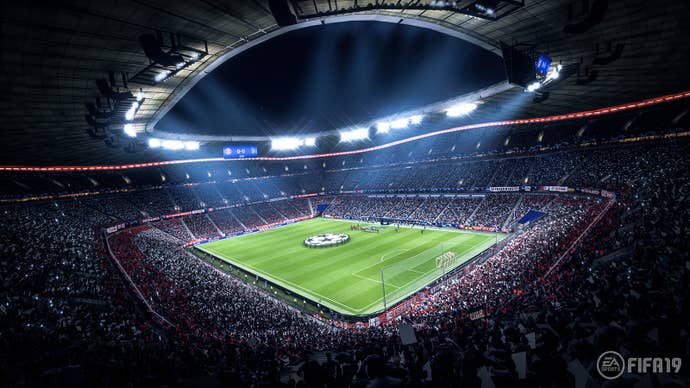
How big of an update can fans anticipate for career mode?
Matthew Prior: So it's something we'll be talking about as we head up to Gamescom specifically. But I think right now, there's a big update in the sense that the Champions League is in there, and we kind of showed it in the presentation of how we implement that. Obviously Champions League, we had a kind of variation of it, a generic variation of it for years. But I think this time, career mode is the most authentic it's ever been. So that in itself is a big update, and not just the fact that it's in there, but the way we've implemented it. The whole UI takeover, the cinematic scenes within the UI showing the Europa League draw. It's not just Champions League, it's Europa. So I think the integration of that, just in and of itself, is all we can really talk about right now. It is a sufficiently big change to career mode that people will kind of love it because it is now 100 percent authentic.
What do you think next-gen consoles can mean for FIFA?
Matthew Prior: Who knows? We'll kind of wait and see. Obviously, we try to push technology to it's furthest. The more memory, the more processing power, the more we can replicate the real world of football. Ultimately, we have a bar to aim at, and that is what football looks and plays and feels like in the real world. Until we're at a point where you can't differentiate between watching a real game and watching FIFA, we'll always be trying to hit that mark. Whether the next generation of consoles take the graphically abilities to that kind of level, who knows. Obviously if you look at each iteration of past hardware, the step up from FIFA has been huge. We would hope for a similar leap forward in any future consoles.



